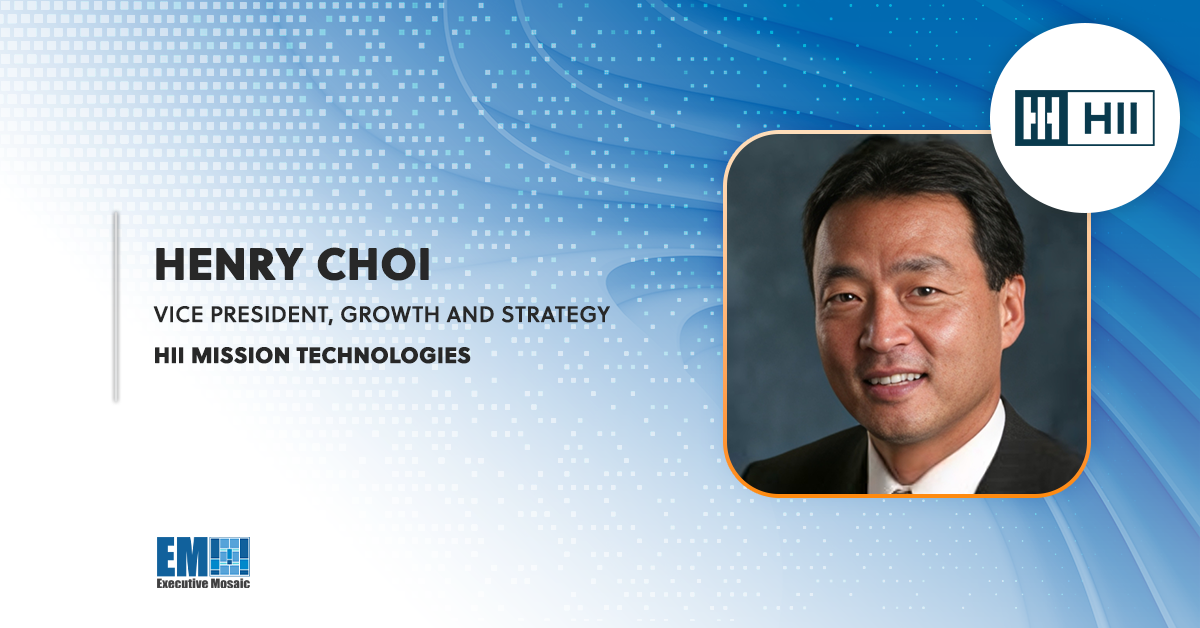Data is king in the digital age, and it has become an increasingly crucial element in informing the United States’ strategies both on and off the battlefield. In this Executive Spotlight interview, Henry Choi, vice president of growth and strategy at HII Mission Technologies, shared his thoughts on how data enables CJADC2, major GovCon market trends and HII’s strategic vision for the future.
Choi is a GovCon industry veteran with more than two decades of experience in some of the sector’s major firms. Prior to his time at HII, Choi was VP of business development at CACI, and before that, he spent more than 15 years at Northrop Grumman.
Read below for Henry Choi’s full interview.
GovCon Wire: What’s your outlook on the global defense landscape? What significant trends are you seeing, and how are those factors moving the GovCon market?
Henry Choi: In today’s data-informed battlefield, agile decision-making is paramount. AI-powered data analytics are a key enabler to providing actionable information to warfighters for their decision-making. Leveraging AI and big data can enhance decisions in various ways. Providing data-driven course-of-action recommendations, insight into the adversary’s patterns of life, algorithm-based battlefield calculations and AI/ML technologies are a few areas we see shaping the GovCon market. HII Mission Technologies has been investing in both AI and big data for decades, and HII’s next-generation data analysis product, IONIC, is being deployed and utilized by customers to support cyber and JADC2 missions.
GCW: What do you think are the most pressing national security threats we’re facing today? How is HII addressing these threats?
Choi: The United States has invested trillions of dollars inventing and reinventing new modern warfare weapon systems. Adversaries have been stealing trade secrets by infiltrating defense industrial base systems and are developing techniques to exploit vulnerabilities. With this global threat environment, cyber-worthiness and the ability to optimize operational efficiencies are critical to securing DOD enterprise systems. To counter these threats, Mission Technologies has been partnered with the U.S. government delivering unique Defensive Cyber Operation (DCO) capabilities.
One of these capabilities is providing expertise using BDP, a government-owned unified platform used for securely ingesting large data sets, storing data on petabyte scales and building and running analytics and visualizing the results. HII has also developed tools like the Functional Discovery Platform tool to scan weapon systems to ensure systems are functioning the way they are designed to. Digital Field Programmable Gate Arrays (FPGAs) and integrated circuits are critical pieces of DOD systems that must be secured and mitigate any vulnerabilities of digital systems. HII continues to develop automated tools and provide expertise to quantifiably assure DOD critical systems are able to operate.
GCW: With all these trends in mind, where are you seeing opportunities for expansion in HII’s portfolio? What new capabilities or markets are you eyeing?
Choi: We already see information superiority and cyberwarfare as decisive advantages to current warfare. As part of the shift to data-centric operations, the DOD recognizes that the data fabric layer is a critical element in connecting and enabling an all-domain force. The data fabric, applied at both the enterprise level as well as at the tactical edge, ingests vast amounts of information from disparate sources across the battlespace. For over a decade, Enlighten, an HII company, has been delivering data fabric solutions through government-off-the-shelf big data solutions. We see opportunity to partner with the services and combatant commands to operationalize the CJADC2 operational requirements through our big data solutions and the IONIC product.
HII also developed SABERHUNT to support hunt-forward operations, which are strictly defensive cyber operations conducted by U.S. Cyber Command at the request of partner nations. SABERHUNT is built in a small form factor deployable sensor, providing mission-essential threat-hunting capabilities on and off DOD information networks. SABERHUNT observes and detects malicious cyber activity on host nation networks at the request of partner nations. SABERHUNT is scalable, modular and reliable, and the sensor provides insights that bolster homeland defense and increase the resiliency of shared networks from cyber threats.
GCW: What factors are influencing your growth strategy as you look toward HII’s future?
Choi: HII is an all-domain defense and technologies partner, recognized worldwide as America’s largest shipbuilder, but we’re so much more with our recently expanded Mission Technologies division. The company is 44,000 strong, and Mission Technologies has more than 7,100 employees. We support seven of 18 intelligence community organizations and eight of 10 COCOMs and their service components focused on C5ISR; cyber, electronic warfare and space; and global live, virtual, constructive simulations and military exercises.
We see Mission Technologies as the growth engine for HII. We continue to expand partnerships to provide exquisite solutions closing capability gaps. With the recent establishment of Space Command and Space Force, we see growing opportunities to deliver HII unique capabilities to both organizations.



